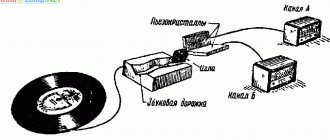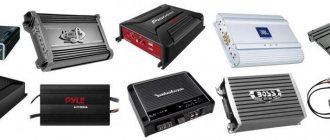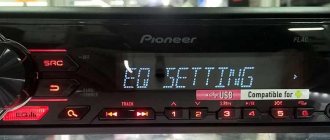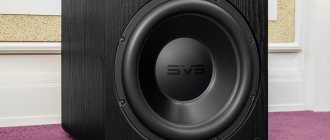The history of subwoofers - DRIVE2
A subwoofer (from the English “subwoofer”) is an acoustic system designed to reproduce ultra-low frequencies, namely from 5 to 200 Hz. Considering that a person hears sound with a frequency of at least 16 Hz, and low-frequency speakers of other acoustic systems reproduce sounds from 50 Hz, it is easy to understand for what purpose subwoofers were invented - to achieve a more complete and accurate sound, to feel this sound even with the body.
Subwoofer design
As for the design of this device, it looks quite simple: it is most often a large case, usually cubic in shape, usually made of wood materials. It has a built-in ultra-low-frequency head and a powerful amplifier serving the frequency range of 5-200 Hz. Here it should be clarified that some models may not have a housing or a built-in amplifier. As for the types of housing, today there are 4 options:
closed case - without any holes; bass reflex - closed case with an output hole in the form of a special tube, which allows you to achieve the deepest bass; with a passive radiator - similar to a bass reflex, but instead of a tube there is a passive radiator;
bandpass - consists of two parts, separated inside by a partition, the first is closed, the second with a bass reflex.
“Ancestors” and “pioneers”
The ancestor of all devices of this kind known to us today was the Radiola speaker system, released in 1926 by RCA. It was equipped with a direct radiation dynamic head, which had a moving coil and a relatively wide frequency range, and was also characterized by low nonlinear distortion. The first two-way design was introduced by the American corporation Bell Labs in 1931. It had a frequency range from 50 to 13,000 Hz and was intended for cinema halls.
The first subwoofer model called AR-1W appeared in 1954, it was demonstrated by the American company Acoustic Research. The system consisted of a long-stroke dynamic head, which was placed in a fairly compact housing. It could reproduce frequencies from 20 Hz. Afterwards several more improved models were released. And in the early 70s, the Jensen company introduced a line of relatively compact speaker systems that were distinguished by much deeper bass.
If we talk about a subwoofer in a car, it appeared around the same time when other types of speaker systems for car interiors were being developed. It was not possible to find the exact year of production of the first car, but we can assume that it hit the market in the 60-70s. There is a mention that the first subwoofer was released by the American company MTX Audio, and it was called Jackhammer, which translated into Russian means “jackhammer”.
Development of subwoofers
Over the years, ultra-low-frequency speakers have developed and improved, and more and more advanced devices have appeared. Subwoofers have become a common part of movie theaters and home living rooms. The more stereo sound developed, the more necessary these speaker systems became. The reason was also new musical media, which were a consequence of the emergence of modern recording formats.
Great demand for subwoofers and other speaker systems for cars appeared in 1978, when 12-volt car audio amplifiers were released, designed to create a stereo effect. Since then, apparently, it has not decreased. As for today, a subwoofer is an essential attribute of a music lover car owner.
www.drive2.ru
History of portable music
Beach, cottage, bench under the entrance or a spontaneous party in nature - today you can listen to music everywhere and at any time. But have you ever thought that half a century ago, playing your favorite track away from your room was an unprecedented luxury? At first, only privileged members of society - kings, counts and princes - could afford this. Moreover, they could only do this with the help of other people - court artists, whose task was to entertain with their songs and dances. Let alone waterproof speakers, then it was akin to a flying saucer.
Let’s make a comeback to the recent past and figure out how gadgets for music “to-go” have evolved.
Regency TR-1
The history of portable music can begin in 1954, when the Regency TR-1, the world's first transistor radio that could easily fit into a pocket, went into mass production in America. It cost about $50, and for an additional $12 you could buy a set of mini headphones and a leather case.
For the average music lover it was quite expensive, although it was actually sold at cost. Externally, the Regency TR-1 was quite nice, but this receiver could not boast of sound quality, and at some frequencies it was terribly noisy.
Sony TR-55
A year later, Sony released its first portable gadget, the TR-55 transistor radio, manufactured in Japan for local use. It worked on five transistors and weighed 560 grams - you couldn’t put it in your pocket. Which is not surprising, since for some reason the manufacturers of this receiver decided to be inspired by the design of Lincoln cars.
Stereobelt
In 1972, the first cassette player saw the light of day. It was invented by television producer and editor Andreas Pavel and offered to be produced by several electronics manufacturers, including Yamaha and Philips. However, no one agreed to invest in Pavel’s invention, arguing that people would be embarrassed to walk down the street wearing headphones. Only five years later, the author of Stereobelt managed to obtain a patent for the device in Italy, and then sign contracts in the USA, Germany, England and Japan.
Boombox
The first boombox, a portable stereo tape recorder with two cassettes and a radio, was invented by brothers Stacy and Scott Woelfel in 1975. For the case, they used a simple wooden box, into which they built speakers and an 8-track car radio.
In the 1980s, when other companies began producing boomboxes - Panasonic, Sony, Marantz and General Electric - this tape recorder received several more names (for example, ghetto blaster, jambox, boomblaster). In addition, for the history of music, the boombox became not only a tape recorder with a powerful sound that was worn on the shoulder, but also a symbol of the street culture of that time and an integral attribute of the jams and battles of the first rappers and breakdancers.
Cassette players and Sony Walkman
While fashionistas with bulky and loud boomboxes walked the streets of New York, Sony developers practiced mobility. In 1979, they managed to break the record by releasing the brand's first model, the Walkman TPS-L2, which was only two and a half times larger than an audio cassette. To make the device compact, we had to sacrifice the built-in speaker and voice recorder. The gadget quickly gained popularity in its homeland and a year later began to be sold on other continents, albeit under the name Soundabout.
Sony released their Walkman cassette players until 2010, experimenting with features and design. This is how players appeared with two headphone outputs, a more powerful battery, a wired remote control and motors for playback in both directions and a separate one for rewinding.
Despite the fact that the truly first cassette audio player was the Stereobelt, Andres Pavel's laurels went to the Japanese inventors of the Walkman, which is why Pavel sued Sony for many years. Justice triumphed only after the death of the author of Stereobelt.
CD players and Sony Discman
When manufacturers noticed that music lovers were already tired of rewinding film, they began to think about an alternative to cassette players. And again, Sony quickly came to the rescue and got ahead of everyone, which in 1984, two years after the appearance of CDs in mass sales, launched the Discman D-50 line of CD players, which became a logical continuation of the Walkman series and later adopted the same name.
The first model cost $350, which was approximately twice the cost of the device. Due to their rather large dimensions, the fame of CD players was rather sudden, since they were already replaced by digital audio players and flash memory technologies in the 1990s.
MP3 players and MPMan
Another gadget, a fellow member of the “man” family, appeared in 1998 thanks to the Korean company SaeHan and became a pioneer among digital players. On the first MPMan you could download as much as 32 MB or 64 MB of songs, which was a revolutionary amount.
However, the advantages of this device ended with its compactness (it weighed 65 g) and innovative solution: in order to load music onto it, it first had to be encoded in mp3 format using a special encoder, and only then transferred via a parallel port to a docking station connected to player. In general, there was enough trouble.
A few months later, in the same 1998, another MP3 player, Rio PMP300, was released, which was developed by the Americans Diamond Multimedia. It was much more convenient for daily use than MPMan. The Rio PMP300 also had only 32 MB of memory, but it could be increased. This player ran on one AA battery, which was enough for 8-12 hours of non-stop music listening. You could import music to the Rio PMP300 using a cable that connected directly to the computer.
Later, players with built-in hard drives began to gain momentum, which now not only entertained, but also became assistants to students, managers and businessmen. Following this, MP3 players acquired LCD displays on which you could watch videos and read books.
iPod
Another revolution in the world of music was made by Apple, introducing in 2001 the first model of the iPod player with the same proprietary “wheel” for controlling the gadget. This device already had much more capabilities: starting with the fact that it could store a huge cloud of files, and ending with a connection to iTunes, with which you could download individual songs to the player, and not just entire albums.
Portable speakers
Thanks to the advancement of technology, we can not only spend our evenings watching the offer of cat videos on Instagram. Today you can listen to your favorite music with friends absolutely anywhere. After all, you no longer need to carry huge tape recorders or wires to connect acoustics. You just need to throw a portable speaker in your backpack and have a disco wherever you want.
Today, portable acoustics have greatly advanced in sound quality - they sound so good that you are not ashamed to turn on your favorite tracks. Moreover, now you can charge your phone from it, listen to the radio if you’re tired of your playlist, and most importantly, don’t be afraid if it accidentally falls into the pool. We grew up during the popularity of waterproof watches, when we anxiously looked for “water resistance” on the case. We washed the dishes without taking off our watches, showing others with an arrogant look that we had a waterproof gadget. Now the waterproof speaker brings back that childhood thrill. After all, today you can jump into the pool directly with a speaker, and then, epoch-making, like Aphrodite from the sea foam, get out of the water to the anthem of Kazantip 2005 under water. Yes, even if you throw it into the pool and then take it out, the music will not stop.
#bit.ua
Read us on Telegram
Tags: history music portable music
Share: SHARE TWEET POCKET
A subwoofer is... What is a Subwoofer?
Subwoofer is an acoustic system that reproduces sounds of very low frequencies (from approximately 5 to 200 Hz).
Application
Low sound frequencies are poorly localized, meaning it is more difficult for a person to determine where the sound is coming from. It turns out that in a multi-band audio system you can make one large low-frequency speaker for the entire system, and keep only mid- and high-frequency speakers in the remaining speakers. This makes the speaker system more compact, reduces cost, and allows you to place a bulky and vibrating subwoofer in a place where it will not be in the way (for example, under a table). In addition, by choosing a suitable location for the subwoofer, you can try to suppress the low-frequency standing waves that inevitably arise in a small enclosed room.
The subwoofer is usually used in systems designed for watching modern films rich in special effects and listening to modern music (especially electronic) - convincing transmission of low frequencies is important in them.
A common problem with subwoofer systems is poor matching of the amplitude-frequency and phase-frequency characteristics of the satellites and the subwoofer. At the junction of the frequency response there can be either a dip or an overestimation of the level due to a mismatch in the frequency range or interference of waves with different phase shifts. Therefore, on some subwoofers it is possible to adjust its upper limit frequency and phase.
Subwoofer
Types of subwoofers
In relation to the power amplifier, subwoofers are divided into active and passive.
An active subwoofer has a built-in power amplifier (which allows you to remove the low-frequency load from the amplifier) and an active crossover, which allows you to filter out high frequencies, making it easier to match the subwoofer with wideband speaker systems. Can receive a line level signal (with RF already removed) from a separate source channel. Can be connected between the broadband speaker and the signal source (pass-through). Often it has additional capabilities for adjustment to specific application conditions (phase rotation, frequency response adjustment, position of crossover cut points, cut slope).
A passive subwoofer is not equipped with a power amplifier, so it is connected “in parallel” with the main stereo speakers, or to a separate power amplifier channel. The main disadvantage of connecting a passive subwoofer through is that it additionally “loads” the output amplifiers of the stereo channels. This sometimes reduces the overall volume and dynamics of the audio system. In addition, the presence of a passive crossover on the signal path from the power amplifier to the speaker system cannot have a positive effect on sound quality. Due to the lack of adjustment tools on board, the passive subwoofer is very demanding when it comes to placement in the room; to configure it, you need to move it until you “find” good bass.
Types of structures
- Horn loaded subwoofer. The horn is most often folded.
- Closed box. Type of acoustic design without additional radiators. The low-frequency speaker is installed on one of the walls of the sealed box.
- Bass reflex (vented box). A type of acoustic design with outputs in the form of tuned pipes from which air exits, thereby radiating sound from the rear of the diffuser. The choice of bass reflex size depends on the parameters of the speaker, the volume of the cabinet and the frequency to which it is tuned. Above the tuning frequency, the bass reflex prevents excessive swinging of the speaker cone, and the sound waves emanating from the rear side of the speaker, passing through the bass reflex, change phase and add up with the waves on the front side. At the tuning frequency, vibrations of the diffuser are minimal, and most of the sound energy is emitted by the bass reflex. The use of a bass reflex allows for increased efficiency compared to a similar closed enclosure, which significantly increases the output at low audio frequencies, and in some cases allows you to expand the frequency range.
- Passive radiator (passive radiator). This type of acoustic design is akin to a bass reflex. Another diffuser without a voice coil and magnetic system is installed in the housing. The sound wave emanating from the membrane of the passive radiator is added to the wave of the low-frequency speaker. By changing the mass and dimensions of the passive radiator diffuser, you can change the lower operating frequency of the Subwoofer.
- Bandpass (bandpass) A bass reflex box divided in the middle by an additional wall into chambers of different volumes. The speaker is placed on the partition between the cameras. The efficiency of the design is higher than that of a bass reflex. The name bandpass comes from the cabinet's ability to limit the frequency response of the subwoofer.
There are 3 types of bandpasses: 4th category, 6th category type-A, 6th category type-B. 4th category: a box with two chambers and one bass reflex on the top chamber. 6th category, type A: a box with two cameras and two bass reflexes, each with its own camera and configured in its own way. Quite complicated to design and configure. 6th category, type B: a box with two chambers and two bass reflexes, each for its own camera, but from the lower chamber the bass reflex is directed to the upper chamber, so the upper bass reflex becomes common to the two cameras.
Designation for multi-column systems
Multi-column systems are usually denoted as “number of satellites. number of subwoofers”, that is:
- 2.0 - two columns;
- 2.1 - two speakers and a subwoofer;
- 4.0 - four columns;
- 4.1 - four speakers and a subwoofer;
- 5.1 - five speakers and a subwoofer;
- 7.1 - seven speakers and one subwoofer;
- 7.2 - seven speakers and two subwoofers;
- 7.4 - seven speakers and four subwoofers;
see also
- Acoustic system
- Speaker
- Radio tape recorder
dic.academic.ru











